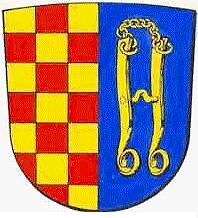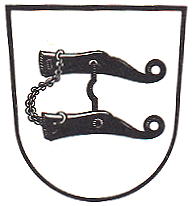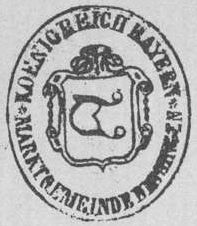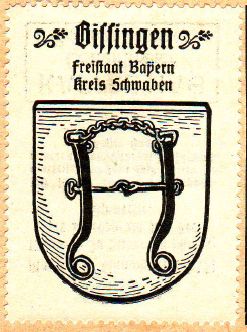Bissingen: Difference between revisions
Knorrepoes (talk | contribs) m (Text replacement - "{{media}}" to " {{de1}} {{media1}}") |
Knorrepoes (talk | contribs) m (Text replacement - "{{de}}" to "") |
||
| Line 1: | Line 1: | ||
'''BISSINGEN''' | '''BISSINGEN''' | ||
Revision as of 14:57, 26 December 2022
BISSINGEN
State : Bayern
District (Kreis) : Dillingen an der Donau
Additions : 1971 Buggenhofen, Burgmagerbein, Gaishardt, Göllingen, Hochstein, Kesselostheim, Unterbissingen; 1972 Diemantstein, Fronhofen, Thalheim, Warnhofen; 1978 Leiheim, Oberliezheim, Unterringingen, Stillnau, Zoltingen
| German |
Gespalten; vorne geschacht von Gold und Rot; hinten in Blau ein senkrecht stehendes, goldenes Pferdegebiss mit Kinnkette. |
| English | No blazon/translation known. Please click here to send your (heraldic !) blazon or translation |
Origin/meaning
The arms were granted on March 13, 1974.
As the new municipality more or less formed the same territory as the former Hohenburg estate, it was decided to combine the chequered arms of Hohenburg with the canting horse-bit (Biss in German) taken from the old arms.
The old arms were officially granted in 1839 by King Ludwig I of Bayern in the silver and black, see below.
| The arms from 1839 |
The municipal stamp shown in 1892 |
Older sources indicate that the colours previously were gold and blue, why the colours were changed is not known. The new arms were granted with these historical colours. The bit already appeared on the oldest seal of the town, known since 1653, but probably dates from the 16th century.
Hupp showed the arms rotated 90 degrees, see below.
| The arms by Hupp in the Kaffee Hag albums +/- 1925 |
Literature: Hupp, 1920-30s; Stadler, , 1964-1971, 8 volumes; www.bissingen.de



